Literature plays a crucial role in shaping local identity by reflecting cultural values and shared experiences. It captures unique narratives and traditions while fostering community pride. Various genres, such as realism and folklore, offer insights into local issues and dialects. Literary festivals enhance this connection, promoting cultural tourism and community engagement through storytelling.
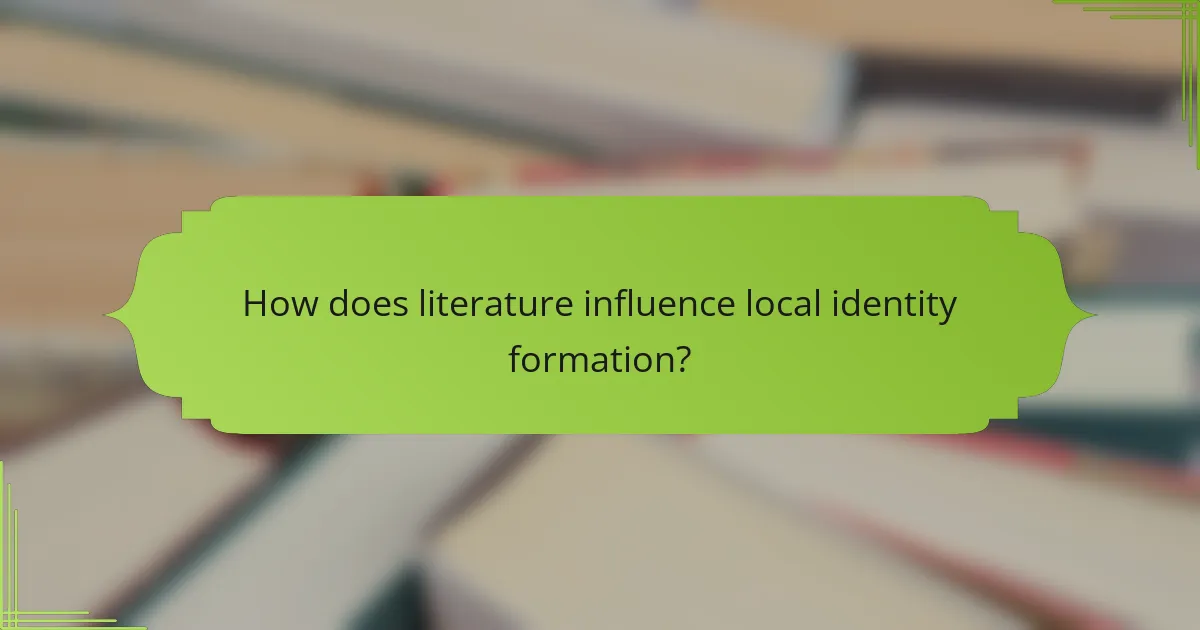
How does literature influence local identity formation?
Literature significantly influences local identity formation by reflecting cultural values and shared experiences. It fosters a sense of belonging and community among residents. Through storytelling, literature captures unique local narratives, traditions, and dialects, reinforcing cultural heritage. As a result, it shapes how individuals perceive their identity in relation to their surroundings. Local authors often highlight specific regional issues, creating a dialogue that resonates with the community. This connection between literature and identity encourages pride and continuity within local cultures.
What role do cultural narratives play in shaping community values?
Cultural narratives significantly shape community values by reflecting shared experiences and beliefs. These narratives create a sense of identity, guiding moral principles and social norms. For instance, literature often encapsulates local stories, emphasizing themes of resilience and unity. As communities engage with these narratives, they reinforce collective values, fostering a deeper connection among members. This process highlights the unique attributes of local identity, as literature serves as a vessel for cultural preservation and transformation.
How do local authors contribute to a sense of belonging?
Local authors foster a sense of belonging by reflecting community experiences and values in their work. Their narratives often resonate with local culture, creating shared identities among readers. This connection enhances community cohesion and pride, as residents see their stories represented. Furthermore, local authors can inspire dialogue and collaboration, strengthening social bonds within the community.
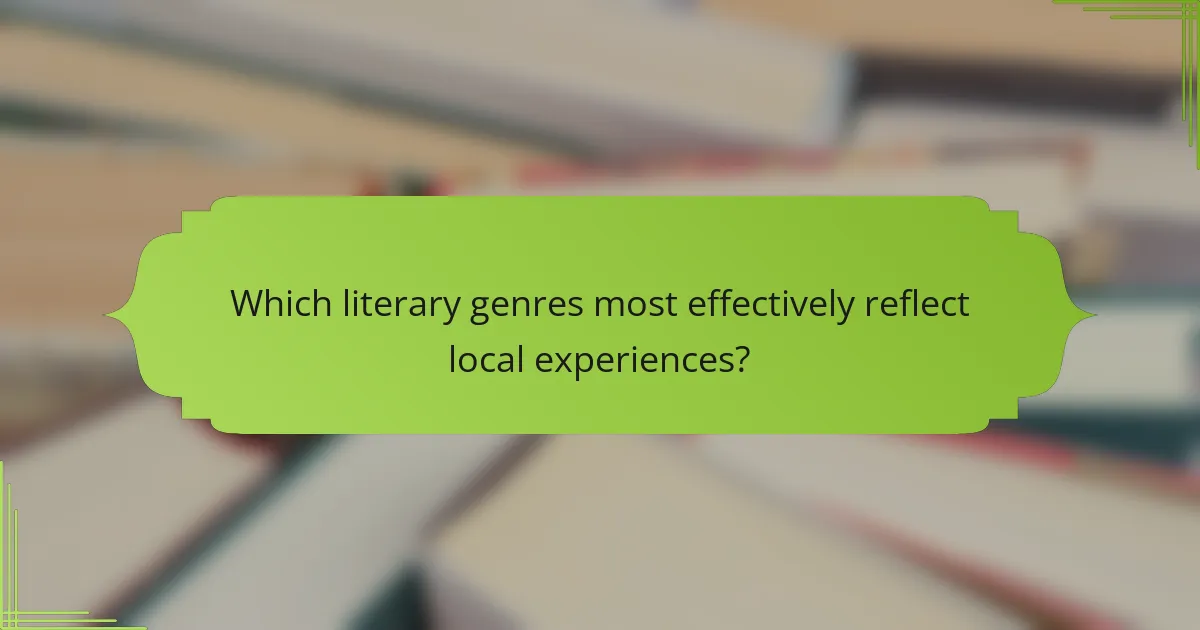
Which literary genres most effectively reflect local experiences?
Literary genres that effectively reflect local experiences include realism, regionalism, and folklore. These genres capture the nuances of culture, tradition, and social issues specific to a locality.
Realism portrays everyday life and social conditions, allowing readers to connect with authentic experiences. Regionalism focuses on the characteristics of a specific geographic area, emphasizing local dialects and customs. Folklore preserves oral traditions, myths, and legends, providing insight into the values and beliefs of a community.
Each genre contributes uniquely to shaping local identity, offering a lens through which readers can understand and appreciate diverse experiences.
What is the impact of regional folklore on contemporary literature?
Regional folklore significantly enriches contemporary literature by infusing it with cultural identity and historical context. Folklore provides a foundation for storytelling, offering unique narratives that reflect local values and traditions. This integration fosters a sense of belonging and continuity within communities.
Contemporary authors often draw inspiration from regional myths, legends, and oral traditions, creating works that resonate with readers on a personal level. For example, the use of local dialects and settings enhances authenticity, making stories relatable and grounded in specific cultural experiences.
Moreover, folklore often addresses universal themes through localized lenses, allowing contemporary literature to explore complex issues like identity, morality, and social change. As a result, the impact of regional folklore on literature not only preserves cultural heritage but also shapes modern narratives that speak to diverse audiences.
How do historical novels shape perceptions of local heritage?
Historical novels significantly influence perceptions of local heritage by intertwining narrative with cultural identity. They provide readers with immersive experiences that highlight historical events and local customs. Through rich storytelling, these novels evoke emotional connections to places and traditions, fostering a sense of belonging.
Moreover, they often incorporate unique attributes of local history, allowing readers to explore distinct cultural narratives. This engagement can lead to greater appreciation for local heritage, as readers gain insights into the lives and struggles of past communities. As a result, historical novels serve as vital tools for cultural preservation and identity formation.
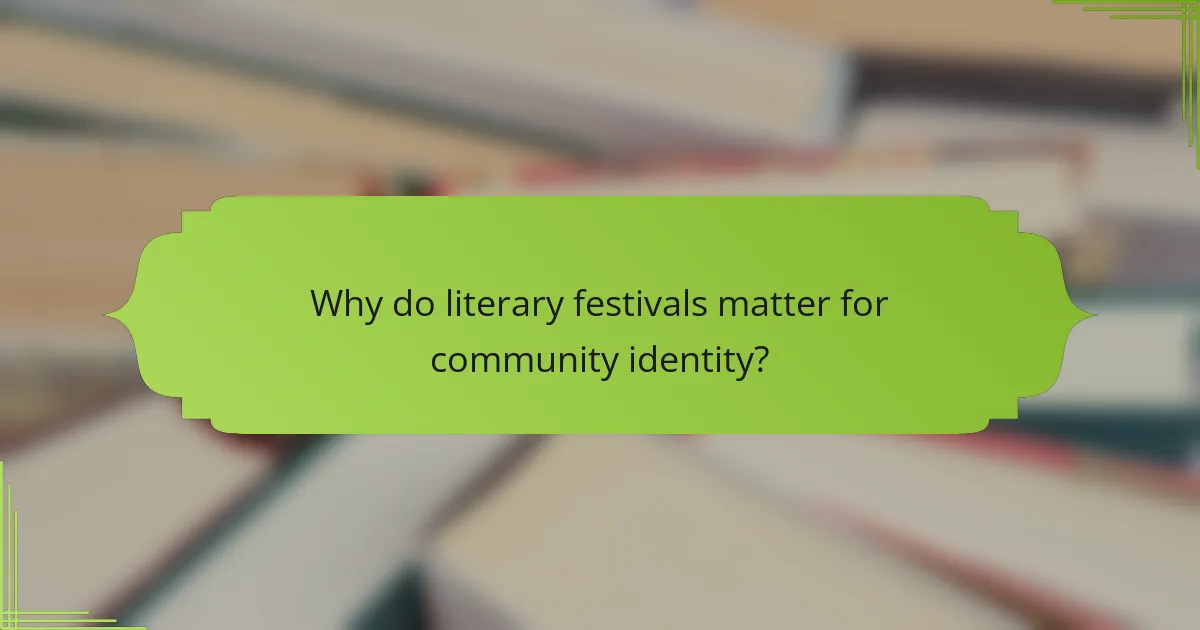
Why do literary festivals matter for community identity?
Literary festivals significantly enhance community identity by fostering local culture and shared experiences. They provide platforms for diverse voices, encouraging dialogue and collaboration among residents. These events celebrate local authors and stories, reinforcing a sense of belonging. Moreover, they attract visitors, stimulating local economies and promoting cultural tourism, which further strengthens community ties. Through literature, festivals create a unique narrative that reflects the values and history of the community, making them essential for cultural cohesion.
How do events like book fairs foster local pride?
Events like book fairs foster local pride by celebrating regional literature and authors. They create a platform for community engagement and cultural exchange. Local authors gain visibility, which strengthens the community’s literary identity. Additionally, these events often showcase local history and traditions, reinforcing a sense of belonging among residents. As a result, book fairs become a celebration of local culture and creativity.
What are the economic benefits of literary tourism in local areas?
Literary tourism provides significant economic benefits to local areas by attracting visitors who contribute to the local economy. It boosts revenue through increased spending on accommodations, dining, and local attractions.
Cultural festivals centered around literature can enhance community engagement and promote local authors, further enriching the area’s identity. For instance, towns associated with famous authors often see a rise in tourism-related jobs, supporting local businesses.
Additionally, literary trails and landmarks create unique experiences that differentiate destinations, fostering sustainable tourism. This niche market encourages preservation of literary heritage, which can lead to long-term economic stability for these communities.
Overall, literary tourism not only enhances local identity but also serves as a vital economic driver in many regions.
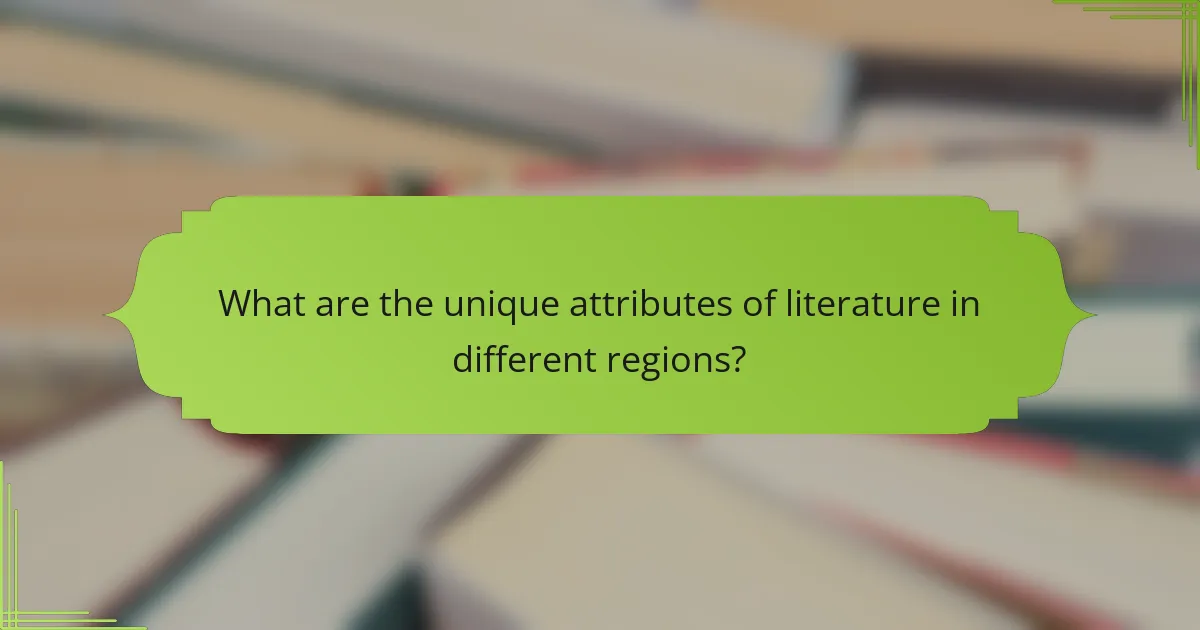
What are the unique attributes of literature in different regions?
Literature in different regions possesses unique attributes that reflect local identity. These attributes include cultural themes, linguistic styles, and historical contexts. For example, African literature often emphasizes oral traditions, while European literature frequently explores philosophical ideas. Additionally, regional folklore and mythology shape narratives, creating distinct literary voices. The integration of local dialects and languages further enriches the literature, making it a vital expression of community identity.
How does the language of literature affect cultural representation?
Literature profoundly influences cultural representation by reflecting and shaping local identities. Through storytelling, authors convey unique cultural narratives that resonate with their communities. This connection fosters a sense of belonging and pride, while also enabling diverse perspectives to emerge. Literature acts as a mirror, revealing societal values, traditions, and challenges. As a result, it plays a crucial role in preserving cultural heritage and promoting understanding among different groups.
What are the distinct themes found in local literature across regions?
Local literature across regions often reflects distinct themes that shape cultural identity. These themes include community, historical narratives, and regional landscapes.
Community themes emphasize social connections, shared experiences, and collective memory, often portraying the values and traditions unique to a locality. Historical narratives highlight significant events or figures that have influenced local identity, providing context and continuity. Regional landscapes are vividly depicted, showcasing the natural environment and its impact on the inhabitants’ way of life.
Additionally, themes of resilience and transformation frequently emerge, illustrating how communities adapt to change while maintaining their unique identities. These literary themes not only enrich local narratives but also foster a sense of belonging among readers.
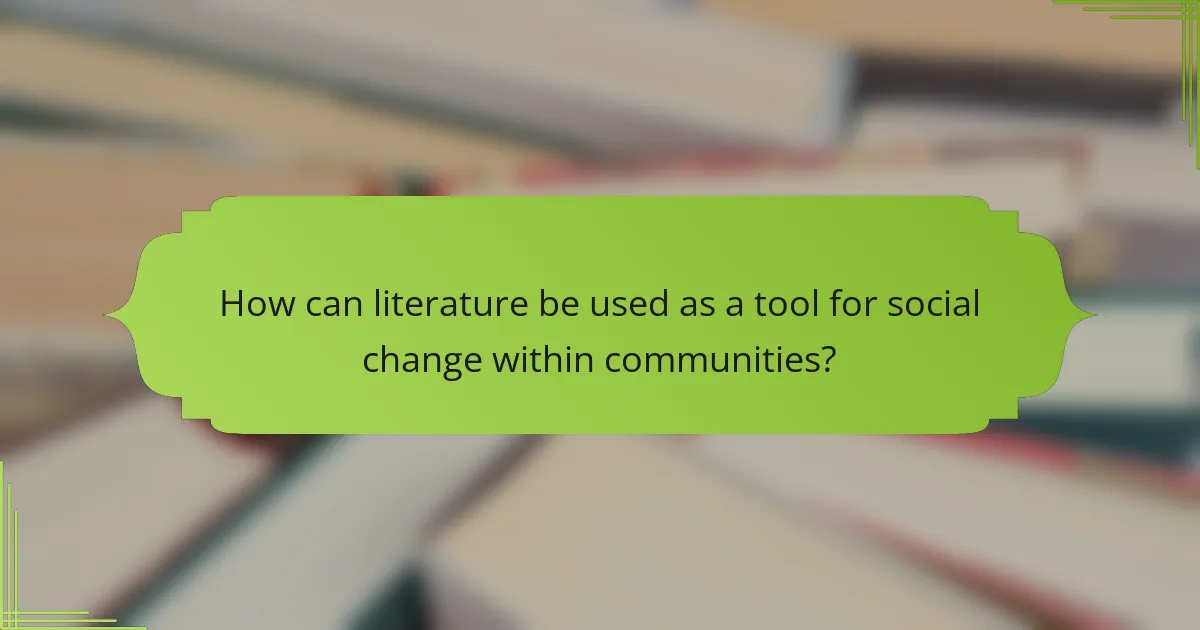
How can literature be used as a tool for social change within communities?
Literature can effectively drive social change by fostering community engagement and promoting awareness. It serves as a mirror reflecting societal issues and a catalyst for dialogue among community members.
Through storytelling, literature can highlight local struggles and triumphs, creating a shared understanding and identity. This shared narrative fosters unity and motivates collective action.
Moreover, literature often addresses themes of justice, equality, and resilience, inspiring readers to challenge the status quo. By engaging with diverse perspectives, communities can cultivate empathy and drive transformative change.
Literary initiatives, such as book clubs or local author events, can further strengthen community bonds, encouraging collaboration and active participation in social issues.
What are examples of literature that have sparked local activism?
Literature has inspired local activism through powerful narratives and themes. Examples include “The Grapes of Wrath” by John Steinbeck, which highlighted the struggles of displaced farmers, and “Silent Spring” by Rachel Carson, which sparked environmental movements. “The Jungle” by Upton Sinclair exposed labor exploitation, leading to reforms. “To Kill a Mockingbird” by Harper Lee addressed racial injustice, influencing civil rights activism. “The Handmaid’s Tale” by Margaret Atwood has resonated in discussions about women’s rights. These works illustrate literature’s role in shaping local identity and driving social change.
How do literary works address social issues relevant to local populations?
Literary works address social issues relevant to local populations by reflecting their unique cultural contexts and challenges. They provide a platform for marginalized voices, fostering awareness and empathy. Through storytelling, literature can challenge societal norms and inspire change. For instance, narratives about poverty or discrimination resonate deeply, prompting discussions and actions within communities. These works often serve as historical records, preserving local identities and experiences for future generations.
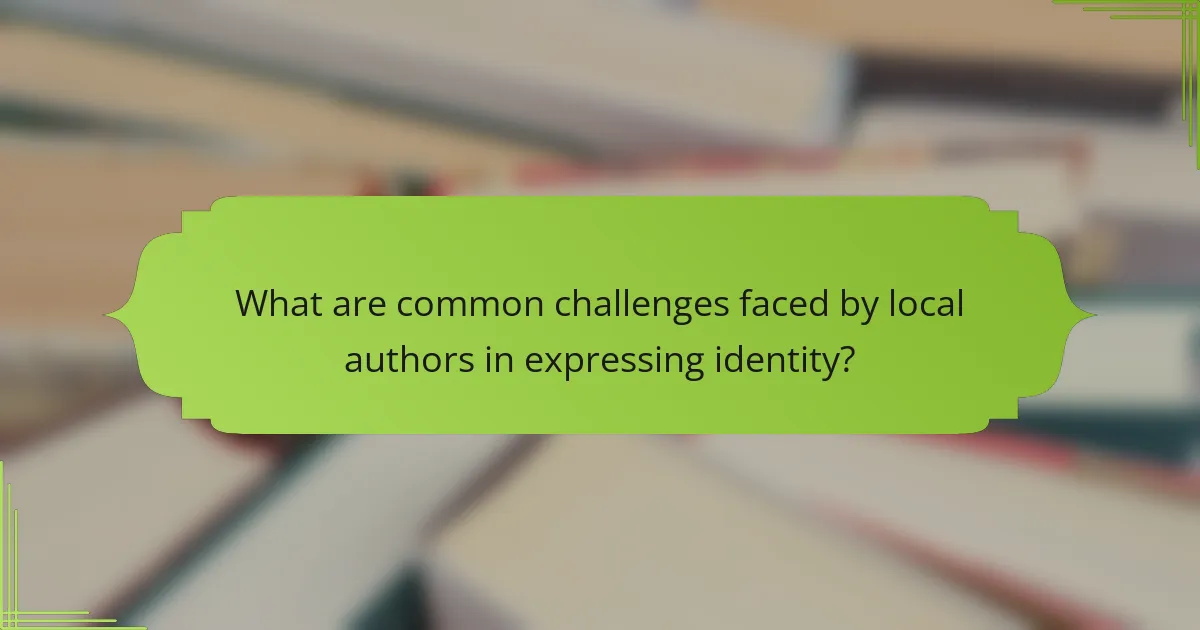
What are common challenges faced by local authors in expressing identity?
Local authors often face challenges in expressing their identity through literature due to cultural barriers, limited resources, and audience perceptions. These obstacles can hinder their ability to authentically convey their unique experiences and perspectives.
Cultural barriers may include societal norms that discourage personal storytelling or a lack of representation in mainstream literature. Limited resources often manifest as insufficient access to publishing platforms or financial support, which restricts authors’ opportunities to share their work. Audience perceptions can also play a role, as readers may have preconceived notions about what local narratives should entail, leading to potential misinterpretations of an author’s intent.
Additionally, local authors may struggle with balancing authenticity and marketability. They often grapple with the pressure to conform to popular trends while striving to maintain their unique voice. This tension can complicate their literary journeys and impact the role of literature in shaping local identity.
How do publishing barriers affect representation in literature?
Publishing barriers significantly limit representation in literature by restricting diverse voices and perspectives. These barriers include economic constraints, access to publishing resources, and systemic biases that favor certain narratives. As a result, local identities may be underrepresented or misrepresented, impacting cultural richness. Diverse literature fosters community connection and understanding, highlighting the need for inclusive publishing practices to enhance representation.
What strategies can local writers use to overcome these challenges?
Local writers can overcome challenges by fostering community engagement, utilizing digital platforms, and collaborating with local organizations. These strategies enhance visibility and connection to local identity.
Community engagement creates a supportive network, allowing writers to share experiences and resources. Digital platforms expand reach, enabling writers to showcase their work beyond local boundaries. Collaborating with local organizations can provide funding, mentorship, and promotional opportunities, enriching the literary landscape.
By implementing these strategies, local writers can navigate obstacles while celebrating and shaping their unique cultural narratives.
What role does digital media play in promoting local literature?
Digital media significantly enhances the visibility and reach of local literature. Through social media platforms, authors can share their work, engage with readers, and build communities. Digital publishing allows for wider distribution, making literature accessible to diverse audiences. Additionally, online literary events and workshops foster collaboration and dialogue among writers, enriching the local literary scene. This interconnectedness contributes to a stronger local identity, as literature reflects and shapes cultural narratives unique to the community.
What are best practices for nurturing local literary talent?
To nurture local literary talent, communities should focus on creating supportive environments that foster creativity and connection. Establishing writing workshops and mentorship programs can provide essential guidance and resources. Collaborating with local schools and libraries encourages young writers to engage with literature. Organizing literary festivals can showcase talent and create networking opportunities. Promoting local authors through readings and book signings enhances visibility and builds community support.